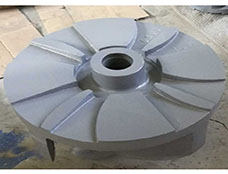+86 311 85258258
+86 311 85258258
Jun. 17, 2020
2 Slag
2.1 Influencing factors
(1) Silicon: Silicon oxide is also the main component of slag inclusion, so the silicon content should be reduced as much as possible.
(2) Sulfur: Sulfide in the molten iron is one of the main reasons for the formation of slag inclusion defects in ductile iron parts. The melting point of the sulfide is lower than that of the molten iron. During the solidification of the molten iron, the sulfide will be precipitated from the molten iron, which increases the viscosity of the molten iron and makes the molten slag or metal oxide in the molten iron difficult to float. Therefore, when the sulfur content in the molten iron is too high, the casting is prone to slag inclusion. The sulfur content of the original molten iron of nodular cast iron should be controlled below 0 06%. When it is between 0 09% and 0 135%, the defects of cast iron slag inclusions will increase sharply.
(3) Rare earth and magnesium: In recent years, studies have suggested that slag inclusion is mainly due to the oxidation of magnesium, rare earth, and other elements, so the residual magnesium and rare earth should not be too high.
(4) Pouring temperature: when the pouring temperature is too low, the metal oxides in the molten metal are too high in viscosity, so it is difficult to float to the surface and remain in the molten metal; when the temperature is too high, the molten slag on the surface of the molten metal It becomes too thin to be easily removed from the liquid surface and often flows into the mold with the metal liquid. In actual production, the pouring temperature is too low is one of the main causes of slag inclusions. In addition, the choice of pouring temperature should also consider the relationship between carbon and silicon content.
(5) Pouring system: Pouring system design should be reasonable, with slag blocking function, so that the molten metal can fill the mold smoothly, and strive to avoid splashing and turbulence.
(6)Molding sand: If there is excess sand or paint adhering to the surface of the molding sand, they can synthesize slag with the oxide in the molten metal, resulting in slag inclusion; the compactness of the sand mold is uneven, and the mold wall with low compactness The surface is easily corroded by the molten metal and forms low-melting compounds, resulting in slag inclusions in the casting.
2.2 Preventive measures
(1) Control the composition of molten iron: Try to reduce the sulfur content in molten iron (<0 06%), add rare earth alloy (0.1%~0.2%) in an appropriate amount to purify the molten iron, and reduce the silicon content and residual content as much as possible Magnesium.
(2) Smelting process: It is necessary to raise the temperature of the molten metal out of the furnace as much as possible, and it is suitable for sedation to facilitate the floating and aggregation of non-metallic inclusions. Remove the slag on the surface of the molten iron, and put a covering agent (perlite, grass ash, etc.) on the molten iron surface to prevent the molten iron from oxidizing. Choose a suitable pouring temperature, preferably not less than 1350 ℃.
(3) For the pouring system to make the molten iron flow stable, it should be equipped with a slag collection bag and a slag blocking device (such as a slag filter, etc.) to avoid the direct channel sprue.
(4) The compactness of the mold should be uniform and the strength is sufficient; the sand in the mold should be blown off when the boxes are closed.

Slurry Pump Parts
3 Graphite floating
3. 1 Influencing factors
(1) Carbon equivalent: The carbon equivalent is so high that a large amount of graphite is precipitated at high temperature in the molten iron. Because the density of graphite is lower than that of molten iron, the graphite vapor floats to the upper part of the casting under the driving of magnesium vapor. The higher the carbon equivalent, the more serious the graphite floating phenomenon. It should be pointed out that too high carbon equivalent is the main reason for graphite floating, but it is not the only reason. Casting size and wall thickness are also important factors affecting graphite floating.
(2) Silicon: Under the condition that the carbon equivalent is unchanged, appropriately reducing the silicon content will help reduce the tendency of graphite to float.
(3) Rare earth: When the content of rare earth is too small, the solubility of carbon in the molten iron will decrease, and a large amount of graphite will be precipitated from the molten iron, which will increase the weight of graphite floating.
(4) Spheroidization temperature and inoculation temperature: In order to improve the absorption rate of magnesium and rare earth elements, domestic experimental studies have shown that the most suitable temperature of molten iron during spheroidization is 1380~1450℃. In this temperature range, as the temperature increases, the absorption rate of magnesium and rare earth increases.
(5) Pouring temperature: In general, the higher the pouring temperature, the greater the tendency of graphite to float. This is because the casting is in a liquid state for a long time, which is conducive to the precipitation of graphite. A.P.Druschitz and W.W.Chaput's research found that if the solidification time is shortened, as the pouring temperature increases, the graphite floating tendency decreases.
(6) Retention time: The residence time from the incubation process to the completion of pouring is too long, which provides conditions for the precipitation of graphite. Generally, this period of time should be controlled within 10 min.
We are an OEM Metal Parts manufacturer. Our company provides high-quality slurry pump parts. If you are interested in our products, please feel free to contact us.